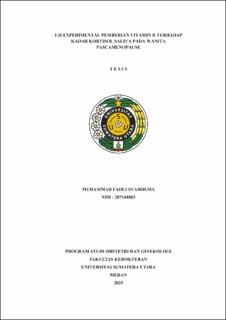Uji Experimental Pemberian Vitamin D terhadap Kadar Kortisol Saliva pada Wanita Pascamenopause
Experimental Study of Vitamin D Administration on Salivary Cortisol Levels in Postmenopause Women

Date
2025Author
Syahdema, Muhammad Fadli
Advisor(s)
Siregar, Muhammad Fidel Ganis
Nasution, Hiro Hidaya Danial
Metadata
Show full item recordAbstract
Background: Menopause marks a major transition in a woman's life. The
definition of menopause is 12 months of amenorrhea or the cessation of menstrual
periods without other causes. Menopause is associated with problematic
symptoms, including hot flashes, sleep problems, mood disorders, sexual
dysfunction, genitourinary dysfunction, weight gain, and cognitive decline. Stress
is closely related to the HPA axis and the adrenal glands as the organs that secrete
the hormone cortisol. Vitamin D supplementation has been used for the treatment
of menopausal disorders including stress reduction.
Methods : Quasi experimental was conducted in the LK study group in Medan
Johor District, Kwala Bekala Village from April 2025 to Mei 2025. 32
menopausal women were divided equally into 2 groups of vitamin D
administration with doses of 1000 IU and 2000 IU. Serum Vitamin D levels and
morning salivary cortisol levels before and after administration were examined in
the laboratory.
Results: The 1000 IU group before vitamin D administration (p = 0.123, r = 0.402),
and after vitamin D administration (p = 0.231 r = -0.317) and the 2000 IU group, the
results did not show a significant correlation between vitamin D serum levels and
salivary cortisol before vitamin D administration (p = 0.252 r = -0.304), and after
vitamin D administration (p = 0.495, r = -0.184). Although there is a tendency for a
negative correlation, these results are not strong enough to conclude a significant
statistical relevance.
Conclusion: In the administration of vitamin D dose 1000 IU, there was no
significant relationship between vitamin D levels and salivary cortisol levels
either before or after supplementation. Although there was a tendency for a
negative correlation, this result was not strong enough to conclude that there was a
statistically significant relationship. Although statistically the difference in the
distribution of DASS categories was not strong enough to reach the level of
significance, clinically it showed a trend of increasing benefits of the 1000 IU
dose in improving psychological symptoms compared to the 2000 IU dose.
Collections
- Master Theses [320]
